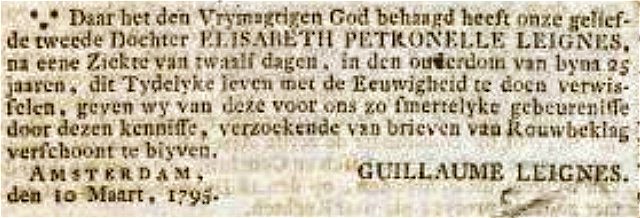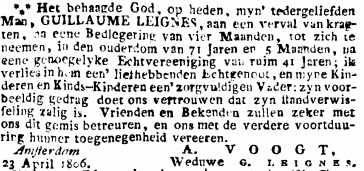Following the Revocation of the Edict of Nantes in France in 1685 by Louis IV , a large number of Huguenots settled in the Dutch republic. In the early part of the 18th century around 12,000 French speaking refugees arrived in Amsterdam, forming approximately 6% of the city’s population.
At that time there was already a large and well-established French community centered around the Waals Hervormde Kerk – the Walloon Church; this following the earlier events of 1581 and the declaration of independence by the Seven United Provinces from the Southern Netherlands and the King of Spain. This caused many French speaking Calvinist in the Southern Netherlands to flee to the new republic in the North and away from the Spanish rulers in the Southern provinces who were making Roman Catholicism the mandatory state religion there.
 The Walloon Church in Amsterdam dates from the year 1409. At that time, it was the chapel of a monastery, the Paulusbroederklooster. The building was put at the disposal of the French-speaking protestant refugees from the Southern Netherlands and France when Amsterdam converted to Protestantism shortly after 1578.
The Walloon Church in Amsterdam dates from the year 1409. At that time, it was the chapel of a monastery, the Paulusbroederklooster. The building was put at the disposal of the French-speaking protestant refugees from the Southern Netherlands and France when Amsterdam converted to Protestantism shortly after 1578.
While there is a Groningen Walloon (or French) Church record indicating Guillaume Leignes went to England in 1754 – did he visit with other Leignes family members who had fled there around the 1700’s? – in 1762 he was back in the Netherlands, in Amsterdam. This is based on a christening record from the Westerkerk in Amsterdam for a Willem Leignes dated 28 Nov 1762 and with Willem Leignes and Antonia Vooght listed as parents.
 We can confirm with some certainty that this Willem Leignes listed as the father was indeed our Guillaume Leignes when three years later – in 1765 – he married Antonia Voogt in Amsterdam. Born in 1741 in Eemness, Utrecht, she was the daughter of Willem Willemsz Voog(h)t and Jannetje Toeback.
We can confirm with some certainty that this Willem Leignes listed as the father was indeed our Guillaume Leignes when three years later – in 1765 – he married Antonia Voogt in Amsterdam. Born in 1741 in Eemness, Utrecht, she was the daughter of Willem Willemsz Voog(h)t and Jannetje Toeback.

View towards the WesterKerk – Amsterdam
It is interesting that, at the time of his son Willem’s christening in 1762, he also registered himself as “Willem”, the Dutch version of Guillaume. And while we can only speculate, this might suggest a temporary break with his family (as well as with his French roots) as they may not have approved of his extra marital relationship and especially not with someone from outside the Huguenot religious community. This might explain the fact that there were no Leignes relatives listed as witnesses at Willem’s christening, other than Willem Voog(h)t (either Antonia’s brother or her father) and a Maria Magdalena Seigeil for whom we have no further information
Guillaume Leignes and Antonia Voogt had 11 children, all born in Amsterdam
— Willem Leignes, (b. 28 Nov 1762, d. ?)
— Marie Magdelaine Leignes, (b. 15-Sep-1765, d.1846)
— Geertruida Elizabeth Leignes, (b. 20-May-1768, d. Dec-1772)
— Elizabeth Petronella Leignes, (b. 30-Apr-1770, d. Mar-1795)
— Andrée Antoinette Leignes, (b. 27-Jan-1772, d. ?)
— Gertrude Elisabeth Leignes, (b. 5-Oct-1773, d. 24-dec-1849)
— Guillaume André Leignes, (12-Nov-1775, d. Dec-1778)
— Pauline Jacobine Leignes, (b. 10-Dec-1777, d. 26-Jan-1857)
— Jeanne Leignes, (b. 11-Nov-1779 d. ?)
— Wilhelmina Antoinette Leignes, (b. 20-Feb-1782, d. <1853)
— Guillaume Leignes, (b.31-Mar-1784, d. Dec-1788)
All but one of the children listed above were baptized in the Walloon Church (“Waals Hervormde Kerk”) in Amsterdam.

Amsterdam- Inner City View
While we may assume that they were a deeply religious family, when Guillaume and Antonia’s second oldest daughter died just shortly before her 25th birthday, we can detect a certain amount of bitterness in her death notice in having to accept yet another death among their 11 children. Sadly, they had already lost three sons aged three, four and ?, as well as a daughter aged four, and perhaps another child since we don’t have a complete record for their children. The death notice for Elisabeth Petronella in 1795 went as follows:

Elisabeth Petronelle Leignes – Death Notice
Translation:
As it has pleased the Almighty God to take our beloved second daughter ELISABETH PETRONELLE after an illness of twelve days, at the age of almost 25 years and exchange her Temporary life for Eternity, we are hereby giving notice of this for us so very painful event and request to be spared from all letters of Condolences.
Various historical records indicate that Guillaume followed in his father Pierre’s footsteps and was an “apotheek” or pharmacist by profession who operated a pharmacy or apothecary in Amsterdam in the Kalverstraat, initially at no.31 and later at no. 218 near the Gapersteeg, where his father Pierre passed away in 1772, and which was later owned or managed by a Jan Cornelis de Meijer Brinkman who was married to Guilleaume’s daughter Jeanne.
An account regarding the training of a pharmacist by the name of Daniël Verhoop around 1800 indicated that, following public eductation in Amsterdam, for a period of 3 months he was a ” leerling bij apotheker Leignes te Amsterdam” (a student by pharmacist Leignes in Amsterdam) – after which he passed his final exams.
As well – and providing evidence to the fact that Guillaume may have spent considerable time in England prior to settling down in Amsterdam – in a publication titled De Hieronymusschool te Utrecht by A. Ekker, we find a reference to Guillaume Leignes training someone by the name of Gerardus Dorn Seiffen in the pharmacology discipline and the fact that “in den omgang met Leignes leerde hij behalve het Fransch ook het Engelsch” (… being around Leignes he learned to speak both French and English)
When Guillaume Leignes died in 1806, his widow Antonia Voogt placed the the following notice in the Amsterdamsche Courant of April 26, 1806.

Guillaume Leignes – Death Notice
Translation:
After a continuing declining health and being bedridden for four months, It has pleased God to take my much beloved husband GUILLAUME LEIGNES to himself, at the age of 71 years and 5 months, and after a blissful marriage of more than 41 years I have lost a loving husband, and my children and grandchildren a thoughtful and caring father: his exemplary behaviour gives us confidence in the sanctity of his transition to the hereafter. Friends and acquaintances are certain to join us in mourning this loss, and to honour us with their lasting sympathy and affection.
He was laid to rest at the cemetery of the French of Walloon Reformed Church in Amsterdam on April 29, 1806.
The following entry in the burial registry of the French Walloon Church in Amsterdam confirms that – when Guillaume buried his last remaining son aged four on December 3rd, 1788 (his other two sons having passed away earlier also at a very early age) – that (male) branch of the Leignes family would now end with his own death in 1806.

Burial record – Guillaume Leignes jr.
The Leignes family name continued on, however, when, firstly, Guillaume’s daughter Andrée Antoinette married Matthias Bakhoven on November 30, 1800, and they named a son born August 2nd in 1802 Guillaume Leignes and who later changed his last name from Bakhoven to Leignes Bakhoven.
As well, he would later marry Pauline Jeanette Kruseman, a first cousin and the daughter of his aunt Gertrude Elisabeth Leignes and Johannes Alexander Kruseman who also had a son named Guillaume Leignes. Born on January 31, 1802, he, too, would later change his last name to Leignes Kruseman, and again – we presume – to ensure the Leignes lineage would not be forgotten and carry on through his family.

Ds. Helena Cornelia Leignes Bakhoven (1910-1996)
A notable descendant of the Leignes Bakhoven family was Helena (Lenie) Cornelia Leignes Bakhoven; Guillaume Leignes Bakhoven (b.1802) was her Great-Grandfather. Born in 1910 in Brielle, Zuid Holland, in 1940 she was the first female Pastor of the Baptist or Mennonite church in the town of Borne in the province of Overijssel. During WW2 she provided shelter in her parsonage to Jews and other people in hiding while she also quartered a German officer! While there were some significant challenges she was able to manage them successfully. After the war she did not want to be recognized for this courageous act . She simply said, “It came my way.” After her death in August of 1996 Helena Cornelia Leignes Bakhoven was distinguished by registration in the Yad Vashem register, the highest honour of the State of Israel.

Amsterdam – Munttower
